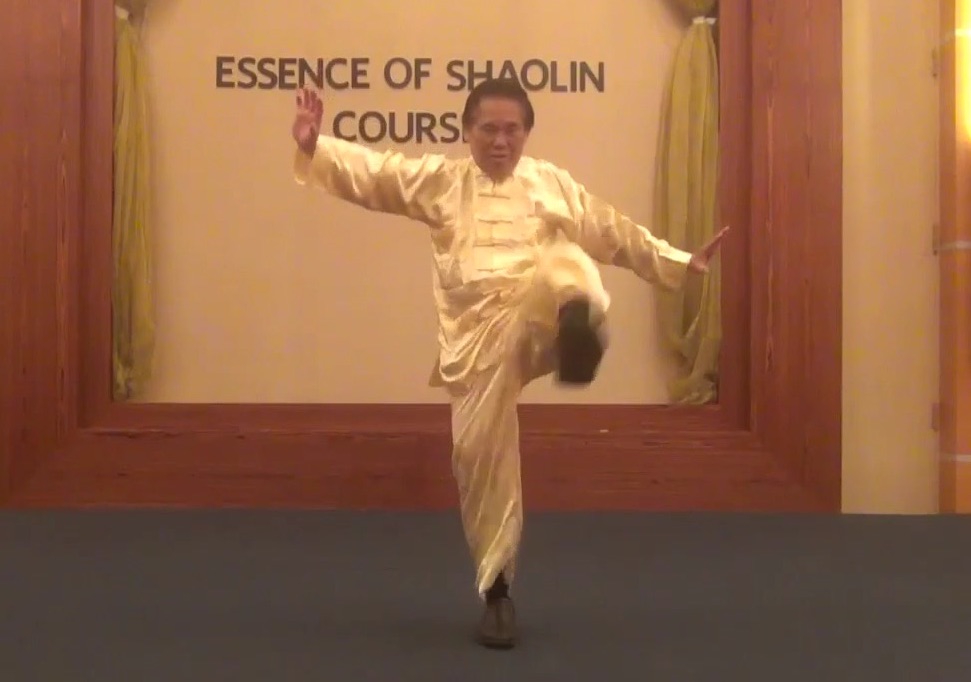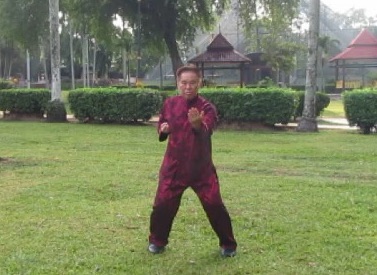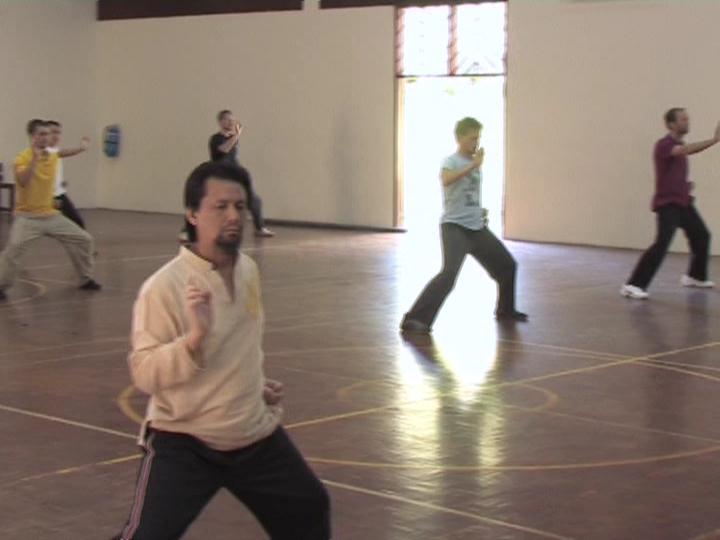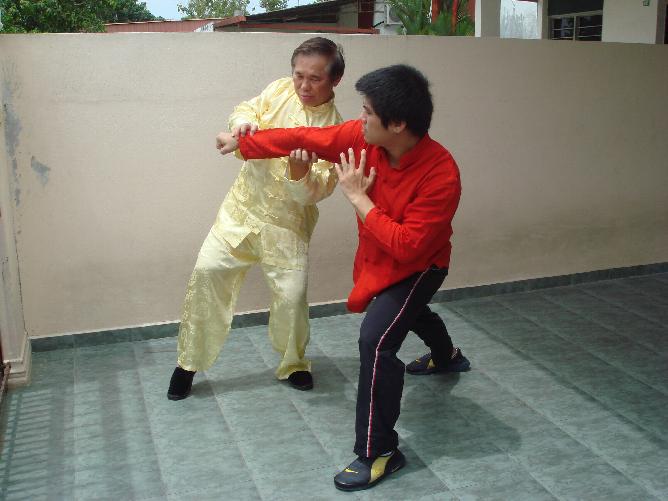SELECTION OF QUESTIONS AND ANSWERS
JULY 2021 PART 3

"Essence of Shaolin Course" in Penang
Question 1
What's the most useful self-defence technique you know?
— Herman, USA
Answer
The best technique is not to fight an opponent, but win him as a friend.There are many techniques I know, and these techniques depend on the opponent. Usually a simple technique can subdue an opponent.
Recently I offered a course on "The Essence of Shaolin". There are 108 techniques in the course, and each one can be used on a high-level opponent, giving him no chance to retaliate.
Question 2
I like to thank you for your immense duty of carrying the Shaolin arts forward! I really appreciate your job and blessings to others by teaching real Shaolin heritage and specially the internal arts of chi-kung.
I have developed hypertension (family heritage). Which exercises are more convenient to reach such a cure?
— Baduanjin, Singapore
Answer
I started traveling and teaching chi kung and Shaolin Kungfu more than 20 years ago because these arts might be lost to humanity. Over the years I have taught in many countries and now have more than 80,000 students. I can now retire, but will still give courses in Malaysia.
I may appear to promote my school, Shaolin Wahnam, but actually I try to save the time of serious enquirers because they will end up learning gentle physical exercise. That was one of the reasons why I started traveling worldwide.
Most people just teach general physical exercise, and they honestly don't realize it. Genuine chi kung has to be learnt personally from a master. A good example is swimming or driving, and a good analogy is Taijiquan, or Tai Chi Chuan in English.
I suggest that you come for my Intensive Chi Kung Course in Penang in Malaysia. You should also spend on your own some days in Malaysia before or after the course.
Some people may wonder what you can learn in a few days of the Intensive Chi Kung Course. You can learn a lot, especially what you cannot learn elsewhere. You will learn during the course itself how to enter into a chi kung state of mind, to generate an energy flow, to direct chi to wherever you want in your body, to have a Cosmic Shower, to build internal force, and to have a one-pointed mind.

Wing Choon Kungfu
Question 3
Grandmaster Cho Shong Tin from Hong Kong explains the difference between his Wing Chun and Tai Chi Chuan. This method focuses on complete body relaxation and awareness, and he calls "Nim Tao", and powers the movements from the mind, "Nim Lik". Once this state is acquired, the practitioner can exert great power. This is achieved by practising the fundamental set "Siu Nim Tao" for prolonged time and in very slow speed
— Florian, Netherlands
Answer
Grandmaster Cho Shong Tin is an expert in Wing Choon Kungfu. It is evident that he has internal force, and is relaxed throughout.
You will notice that I use the term "Wing Choon" instead of the popular term "Wing Chun" because I feel that "Chun" could be mis-pronounced as "sun", like the sun in the sky.
I remember that long ago I asked my sifu, Sifu Choe Hoong Choy, the Patriarch of Choe Family Wing Choon Kungfu, why in our Wing Choon it is called "Siu Lin Tou" whereas in the popular style of Wing Choon in Hong Kong it is called "Siu Nim Tou" ("Siu Nim Tao").
He told me that originally the term was "Siu Lin Tou", which means "the beginning of small practice" as Yim Wing Choon, the founder of Wing Choon Kungfu, always started her training with this practice, but later as the early pronunciation was not written down, the "lin" was mis-pronounced as "lim". He also told me "Siu Lin Tou" included "Cham Kiew" (Searching for Bridge) and "Phew Chee" (Thrusting Fingers) in one set, whereas in "Siu Nim Tou", "Cham Kiew" and "Phew Chee" are practiced as separate sets.
There is much difference between Wing Choon Kungfu and Taijiquan, although both are used for the small exponent against a bigger and stronger opponent. The hallmark of Wing Choon Kungfu is to strike at the shortest distance and the strike is usually linear, whereas in Taijiquan it is to strike when there is an advantage, and the strike is usually circular.
The center line theory is very much in use in Wing Choon Kungfu. The forearm strike of Grandmaster Cho Shong Tin uses the center line theory. I am much influenced by Taijiquan. When an opponent executes a middle punch at me, I would use my left hand as a "slap hand" and simultaneously execute a cup fist with my right hand at the opponent's ribs. It is also using the center line theory, but I execute the pattern from a side, rather than from the center.
When Grandmaster Cho Shong Tin executes "Nim Tao" (Thinking-First) from "Nim Lik" (Thinking-Strength), he probably derives his internal force from "Siu Nim Tou" or "Siu Nim Tao" ("the beginning of thought and practice"). The method to develop internal force is similar. We are totally relaxed. Our main method to develop internal force is "One-Finger Shooting Zen", which first lets energy flow, then consolidates the energy.
Question 4
Would you please elaborate on the difference between "their" internal force, and "our" internal force in methods, application, etc.?
Answer
We have many methods to develop internal force. This may be quite a surprise as many masters and grandmasters have spent many years to develop internal force but to no avail.
Our internal force can be applied universally, i.e. our interal force not only enables us to do better in our martial arts, sports and games, but also enable us to do better in every thing we do, especially in our daily life. Those who practice Taijiquan, generally use flowing force. Those who practice Shaolin Kungfu generally use consolidated force.
I would not comment on "their" method and application of developing internal force, but I would comment on "our" method. Our main method is "One-Finger Shooting Zen", which is regarded as a treasure of our school. It involves both the flow method and the consolidated method. In other words, when we use "One-Finger Shooting Zen", we will have both flowing force and consolidated force.
The application is tremendous. Not only our fingers are powerful, but our fists, palms, legs and all parts of our body are powerful. Not only it will contribute to our kungfu application, as well as sports and games, it will also enhance our health, vitality and longeveity, as well as our peak performance and spiritual joys irrespective of religion. Just imagine. Because of practicing "One-Finger Shooting Zen", whatever we do we can do better, and we will find every day peaceful and happy. It is just too good to be true.

"One-Finger Shooting Zen" in Sabah
Question 5
Would a dedicated student of Shaolin Wahnam be able to perform such feats, as described above and shown in the videos?
Answer
A dedicated student of Shaolin Wahnam would be able to perform the feats of Grandmaster Cho as shown in the videos. The applications might be different.
A dedicated Shaolin Wahnam student should follow the teaching of his instructor. He can get in a year what I would need ten in my students' days.
For example, I took about 20 years to have some internal force. Some external art masters do not have any internal force even when they chase after it for many years. Internal force is not just for combat; it contributes to your health, vitality, longevity, peak performance and spiritual joys irrespective of religion.
Question 6
However, what was happening during this time was miraculous! My horse-riding stance improved even after days of doing nothing, my improvement was if I had practiced the whole time! Even in my chi king, it is extremely noticeable.
— Brian, USA
Answer
You can perform all the levels as you are quite good at kungfu, but it is rewardingly to progress gradually. Remember not to over-train.
It is easy to over-train and the student may not realize it. As I have always mentioned, a Shaolin Wahnam student now takes only one month what I would need a year in my students' days even when I was known as an exemplary student.
I took more than 20 years to have internal force, and more than 20 years to have a chi flow like what our Shaolin Wahnam students now do. Of course I am very happy and proud of that as it shows we have improved tremendously in our teaching methodology.
It usually happens that you have a "plateau" before a rapid rise. The "plateau" is necessary to prepare you for the following uplift. After your rapid rise you will find there is a lot of improvement.

The "three arrvials" -- the arrivals of the heart, hands and feet
Question 7
My business began collapsing. However, I remained focused and smiling from the heart. I have not yet fixed everything with my business, but everything is going very well, and I am on my way to making a success.
Answer
You must spend some time over your business. Your business is your profession, Shaolin Kungfu is your hobby. You can of course use what you have achieved in your Shaolin Kungfu in your business. You would have used many things unconsciously, like your stamina and your zest in your business. But there are many other things you have to transfer consciously, like "the Four Preparations" and "the Three Arrivals".
The Four Preparations are preparing yourself, seeking opportunities, striking when an opportunity arises, and applying tactics and strategies. For example, you went to university; this was starting later but arriving earlier. You look for opportunities in your opponent or in your business. In the unlikelihood that there is no opportunity, you have to create the opportunities yourself.
When an opportunity arises, like when your opponent looks elsewhere or when his chi floats up, you strike instantly. Hence you have to be prepared; you don't wait for the next opportunity. In business, for example, when others are in the world lockdown, you can send a lot of emails to other organizations or individuals to engage their attention. Then you apply your tactics and strategies, like your planned combat sequences or your pressing attack without neglecting your defence on your opponent, or follow-up emails in your business.
The Three Arrivals refer to "the arrival of the heart", "the arrival of the hands" and "the arrival of the feet". You must be prepared for attack or defence, you must have good footwork, and you must connect. In business, you must access the situation, you must place yourself in a favorable position, and you must deliver. If you, for example, send emails to organizations of cooking or folk-dancing, you are not placing yourself in a favorable position. You have to send emails to organizations or individuals who do business with you. Selecting your prospective clients is an important part of successful business.
Question 8
Also, I have been continuing with the Shaolin Eye Exercises. I am now doing all eight daily, and I am even doing them without my glasses!
Answer
The Shaolin Eight Eye Exercises are wonderful.
Long ago, all my children were asked by specialists to wear spectacles, but I prefer the Shaolin Eight Eye Exercises, and none of them wear spectacles.
Today I am over 75 and I work at a computer many hours a day, but I don't wear any spectacles.
LINKS
Selected Reading
- Amazing Techniques in Shaolin Kungfu
- A Wing Choon Kungfu Set
- Entering into a Chi Kung State of Mind
- Our First Taijiquan Combat Sequences in the 1980s
- Welcoming by the Big Family
